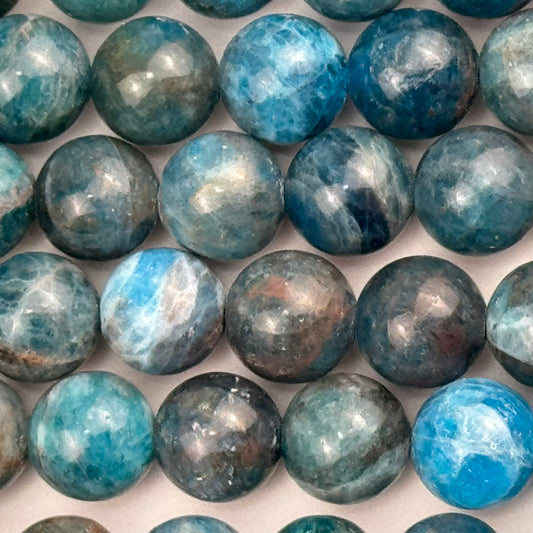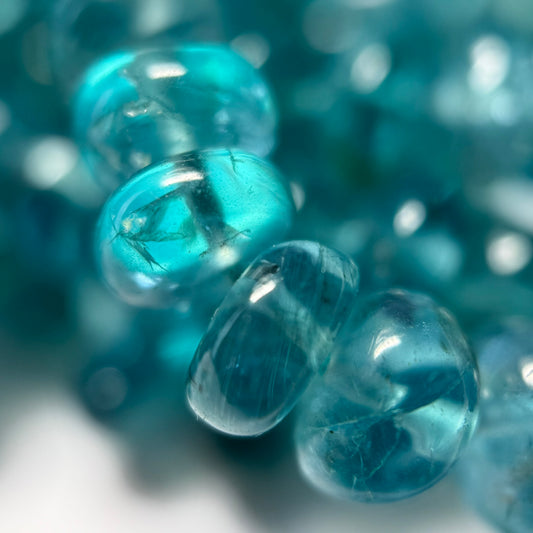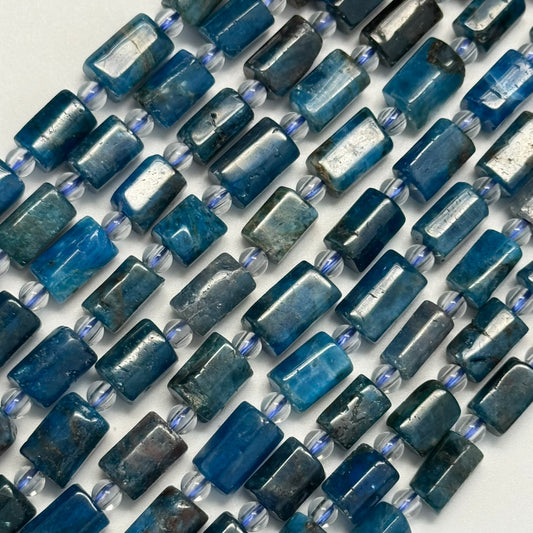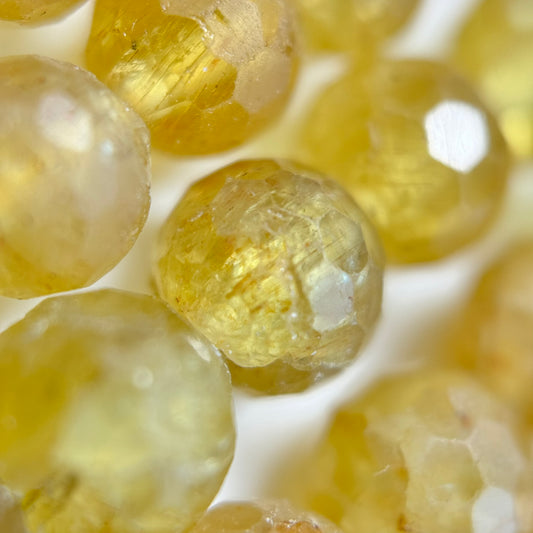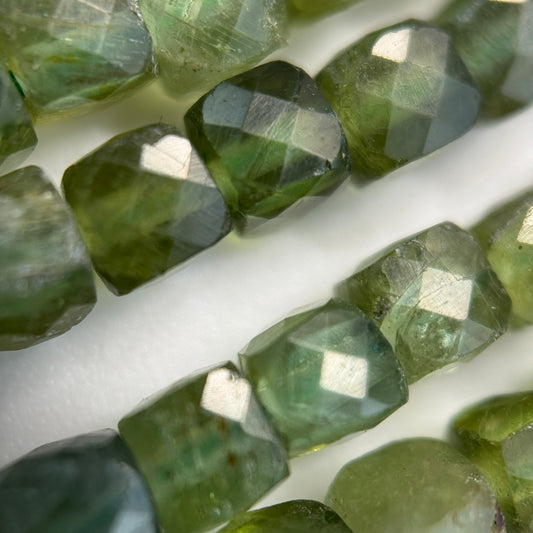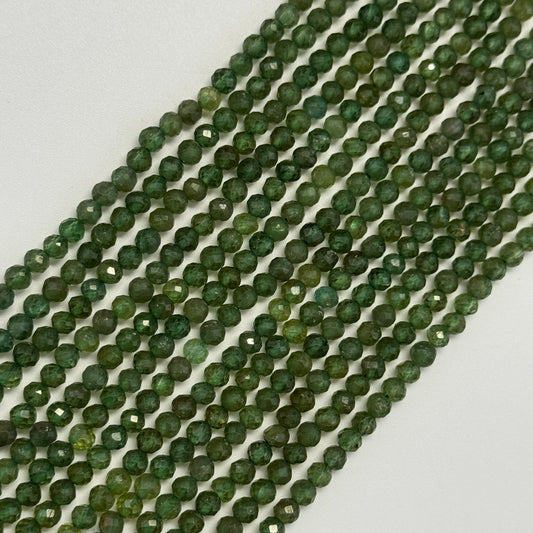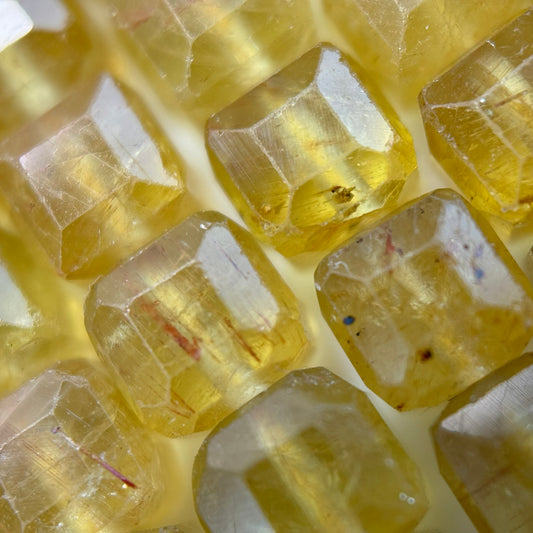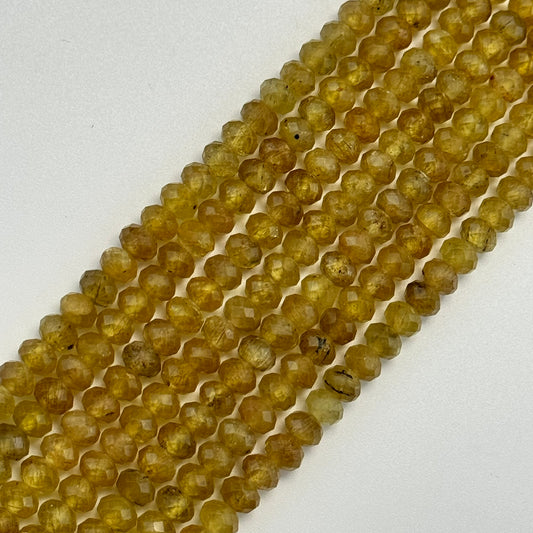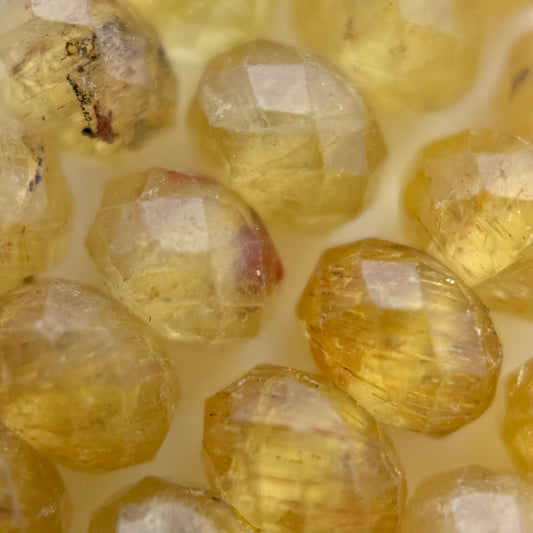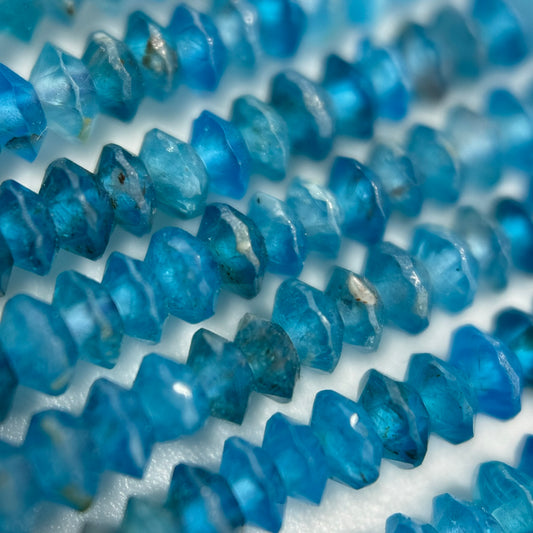Apatite Gemstone Beads
Apatite
Apatite is a group of phosphate minerals with the general chemical formula Ca₅(PO₄)₃(F, Cl, OH). It is a major source of phosphorus, an essential element for biological systems and agricultural fertilizers. Geologically, apatite occurs in igneous, metamorphic, and sedimentary rocks, forming hexagonal crystals with a vitreous lustre.
In gemology, apatite is valued for its variety of vibrant colours, including blue, green, yellow, pink, and violet. Its relatively low hardness of 5 on the Mohs scale limits its use in rings exposed to daily abrasion, but it is prized in earrings, pendants, and beads for its intense hues and transparency.
The name 'apatite' derives from the Greek 'apatein,' meaning 'to deceive,' due to its frequent confusion with other minerals such as beryl or peridot. Its refractive index ranges between 1.628 to 1.649, and it shows weak pleochroism in certain coloured varieties.
Apatite Beads
Apatite beads are widely used in jewelry making due to their vivid colours, particularly neon blue and sea-green shades. They are cut and polished into smooth round beads, faceted rondelles, and chips, enhancing their brilliance in gemstone strands. Because apatite is relatively soft, it requires careful handling during stringing to avoid scratching or chipping.
Blue apatite beads are especially popular in beadwork for their striking tropical-water hues, while yellow apatite beads are valued for their bright golden translucency. Gem-quality apatite beads are often sourced from Brazil, Madagascar, and Myanmar.
Apatite Crystal
Apatite crystals occur in hexagonal prismatic habits, often with striations along their length. Transparent specimens are faceted for collectors, while opaque to translucent pieces are carved or cut as cabochons. In mineral collections, apatite crystals are admired for their clarity, lustre, and distinct hexagonal form.
Blue apatite crystals from Madagascar and Brazil are prized for their neon saturation, while yellow apatite crystals from Durango, Mexico, display golden hues reminiscent of citrine. Due to its softness, apatite is not ideal for high-wear jewelry pieces but remains an important collector mineral.
Apatite in Jewelry Making
Apatite plays a unique role in jewelry making due to its vivid colours and affordability. While its hardness of 5 on the Mohs scale makes it less durable than quartz or sapphire, it is extensively used in pieces that are protected from rough wear, such as earrings, pendants, and necklaces. Jewelers often stabilise or back certain apatite cabochons to enhance durability.
Blue apatite is the most popular in jewelry due to its neon turquoise and Caribbean-blue hues, often compared to Paraíba tourmaline. It is frequently faceted into oval, pear, and cushion cuts for pendants or statement earrings. High transparency and intense colour saturation increase its desirability and value.
Yellow apatite, also known as golden apatite, displays bright canary to honey-yellow tones. These are used in gemstone rings and earrings to bring warmth and brilliance to jewelry designs. Its refractive index gives it an attractive sparkle, especially when well-cut and clean.
Green apatite occurs in olive to vibrant leaf-green shades. It is less common in the market but valued for earth-toned and nature-inspired jewelry collections. In bead making, apatite is typically cut into smooth rounds or faceted rondelles and strung as multi-stone bracelets or necklaces, showcasing its crystal clarity and intense colours.
Apatite Mineral
As a mineral group, apatite includes fluorapatite, chlorapatite, and hydroxylapatite. It is an important component in igneous and metamorphic rocks, indicating phosphorus enrichment during geological processes. Hydroxylapatite forms the primary mineral component of vertebrate bones and teeth, making it biologically critical.
Apatite often appears as an accessory mineral in granite, syenite, and carbonatites, and as a detrital grain in sedimentary deposits. In thin section under a microscope, apatite is colourless to pale brown with high relief and uniaxial positive optical properties.
Apatite Color
Apatite occurs in a diverse colour range due to trace element substitutions within its crystal lattice. Blue apatite’s colour arises from the presence of rare-earth elements and structural defects, producing vivid neon blues and turquoise shades, especially in Madagascar and Brazilian deposits.
Yellow apatite gains its hue from iron and other chromophores, resulting in bright canary, golden, or honey-yellow colours. Green apatite ranges from light moss-green to deep olive shades, often due to iron content. Pink and violet apatite are rarer, typically occurring in pegmatitic environments.
Blue Apatite
Blue apatite is renowned for its intense neon to teal-blue colours. It is commonly sourced from Madagascar, Brazil, and Myanmar. Gem-quality blue apatite is transparent with vitreous lustre, making it highly sought after for beads, cabochons, and faceted jewelry stones despite its relative softness.
Yellow Apatite
Yellow apatite, or golden apatite, displays brilliant shades from bright lemon yellow to honey gold. It is primarily found in Mexico and Brazil and is used in jewelry for its vibrant hue and impressive brilliance when cut. Its clarity and refractive index give it a visual appeal comparable to citrine.
Green Apatite
Green apatite appears in shades ranging from olive to vivid leaf-green. It is less commonly seen in commercial jewelry but is valued by designers for earthy, organic-themed creations. Some specimens may show slight pleochroism under magnification, enhancing their visual interest in gemstone settings.
Apatite Meaning
In metaphysical traditions, apatite is associated with clarity of mind, personal growth, and communication. Blue apatite is linked to the throat chakra, believed to facilitate clear speech and self-expression. Green apatite is thought to connect to the heart chakra, promoting compassion and harmony.
Yellow apatite is often associated with the solar plexus chakra, believed to enhance confidence, creativity, and intellectual clarity. Overall, apatite is considered a stone of manifestation, inspiration, and motivation, aiding in goal setting and personal achievement.
Blue Apatite Meaning
Blue apatite is known as a stone of inspiration and clarity. It is believed to stimulate the intellect and expand knowledge, supporting personal growth and spiritual awakening. Many use it during meditation to deepen insights and improve communication skills.
Yellow Apatite Meaning
Yellow apatite is considered a stone of optimism, creativity, and confidence. Metaphysical practitioners use it to stimulate mental clarity and enhance learning. Its bright golden colour is also linked to attracting prosperity and manifesting goals.
Frequently Asked Questions
What is apatite?
Apatite is a group of phosphate minerals with the general formula Ca₅(PO₄)₃(F, Cl, OH). It occurs in igneous, metamorphic, and sedimentary rocks and is an important source of phosphorus for biological systems and fertilizers.
What is the hardness of apatite?
Apatite has a hardness of 5 on the Mohs scale, making it relatively soft compared to many other gemstones. This means it requires careful setting and handling when used in jewelry to avoid scratches and damage.
What is blue apatite?
Blue apatite is a vivid variety of apatite known for its neon turquoise to deep teal colours. It is primarily sourced from Madagascar, Brazil, and Myanmar and is highly valued in jewelry making despite its moderate hardness.
What is the chemical formula of apatite?
The chemical formula of apatite is Ca₅(PO₄)₃(F, Cl, OH). This indicates it is composed of calcium phosphate with variable amounts of fluoride, chloride, or hydroxide ions substituting in its structure.
Where is apatite found?
Major sources of gem-quality apatite include Madagascar, Brazil, Myanmar, Mexico, and India. It also occurs globally in igneous and metamorphic rocks as an accessory mineral.
How is apatite used in jewelry making?
Apatite is used in jewelry as faceted stones, cabochons, and beads. Due to its brilliant colours, especially neon blue and yellow varieties, it is made into pendants, earrings, necklaces, and bracelets, but care is needed to prevent scratches.
What are apatite beads?
Apatite beads are gemstone beads cut from natural apatite crystals. They are polished into round beads, rondelles, or chips for use in necklaces, bracelets, and earrings, offering vibrant colours in jewelry designs.
What colours does apatite occur in?
Apatite occurs in a range of colours including blue, green, yellow, pink, violet, and colourless. The colour variations are due to trace elements like iron, manganese, or rare earth elements within its crystal structure.
What is the meaning of apatite?
In metaphysical traditions, apatite is considered a stone of clarity, focus, and personal growth. It is believed to enhance learning, creativity, and motivation, supporting goal setting and self-expression.
What is blue apatite meaning?
Blue apatite is associated with the throat chakra and is believed to promote communication, intellectual clarity, and spiritual attunement. It is used in meditation to deepen insights and enhance focus.
What is yellow apatite meaning?
Yellow apatite is linked to the solar plexus chakra and is believed to boost confidence, creativity, and optimism. It is often used for manifesting goals and increasing personal power and clarity.
What is green apatite?
Green apatite appears in shades ranging from light moss-green to vivid leaf-green. It is valued in jewelry making for its earthy tones and is also believed to support emotional healing and connection to nature.
How should apatite jewelry be cared for?
Apatite jewelry should be cleaned gently with mild soap and water. Avoid ultrasonic cleaners, harsh chemicals, and abrasive surfaces. Store pieces separately to prevent scratching from harder gemstones.
Is apatite treated to enhance its colour?
Most apatite is untreated, but some material, particularly lower-grade stones, may be heat-treated to improve colour saturation. Always confirm treatment information when purchasing for accurate disclosure.
What is apatite used for besides jewelry?
Beyond jewelry, apatite is a primary source of phosphorus used in fertilizers, an essential nutrient for plant growth. In biology, hydroxylapatite forms the mineral component of bones and teeth in vertebrates.
Is apatite a rare gemstone?
Gem-quality apatite is considered moderately rare, especially vivid neon blue and yellow varieties. However, as a mineral, apatite is common and widely distributed globally in geological formations.
What is apatite’s refractive index?
Apatite has a refractive index ranging from 1.628 to 1.649, giving it good brilliance when cut well. Its vitreous lustre and clarity make it attractive in faceted and cabochon forms.
Why is apatite called 'apatite'?
The name 'apatite' comes from the Greek word 'apatein,' meaning 'to deceive,' because it is often mistaken for other gemstones such as beryl, tourmaline, or peridot due to its similar appearance.
Can apatite be used for meditation?
Yes, apatite is used in meditation for enhancing focus, clarity, and spiritual attunement. Blue apatite, in particular, is popular for deepening meditative states and facilitating inner vision.
What makes apatite unique among gemstones?
Apatite is unique for its vivid neon colours, especially blue apatite, which resembles Paraíba tourmaline but is more affordable. Its role in biological systems and phosphorus cycles also adds scientific importance beyond its gemological appeal.

